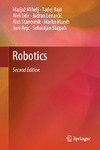| dc.description.abstract | is perhaps difficult to agree on what a robot is, but most people working in
robotics would probably quote the “Father of Robotics”, Joseph F. Engelberger
(1925–2015), a pioneer in industrial robotics, stating “I can’t define a robot, but I
know one when I see one”.
The word robot does not originate from a scientific or engineering vocabulary,
but was first used in the Czech drama “R.U.R.” (Rossum’s Universal Robots) by
Karel Čapek, that was first played in Prague in 1921. The word itself was invented
by his brother Josef. In the drama the robot is an artificial human being which is a
brilliant worker, deprived of all “unnecessary qualities”, such as emotions, creativity,
and the capacity for feeling pain. In the prologue of the drama the following
definition of robots is given: “Robots are not people (Roboti nejsou lidé). They are
mechanically more perfect than we are, they have an astounding intellectual
capacity, but they have no soul. The creation of an engineer is technically more
refined than the product of nature”.
The book Robotics evolved through decades of teaching robotics at the Faculty
of Electrical Engineering, University of Ljubljana, Slovenia, where the first textbook
on industrial robotics was published in 1980 (A. Kralj and T. Bajd,
“Industrijska robotika”). The way of presenting this rather demanding subject was
successfully tested with several generations of undergraduate students.
The second edition of the book continues the legacy of the first edition that won
the Outstanding Academic Title distinction from the library magazine CHOICE in
2011. The major feature of the book remains its simplicity. The introductory
chapter now comprehensively covers different robot classes with the main focus on
industrial robots. The position, orientation, and displacement of an object are
described by homogenous transformation matrices. These matrices, which are the
basis for any analysis of robot mechanisms, are introduced through simple geometrical
reasoning. Geometrical models of the robot mechanism are explained with
the help of an original, user-friendly vector description. With the world of the
roboticist being six-dimensional, orientation of robot end effectors received more
attention in this edition. | en_US |

